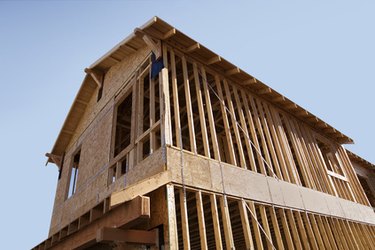
Any structure requiring a permit to build, alter or remodel must be classified by type of construction and occupancy. The International Building Code (IBC) is the foundation of the codes adopted by most municipalities. The IBC specifies five types of construction. Each is defined by the materials used to build it. Material requirements range from being totally noncombustible (Type I) to being constructed from any material allowed by the code (Type V).
Three Little Pigs
Video of the Day
The IBC distinguishes the types with roman numerals: Types I, II, III, IV and V. The story of the Three Little Pigs illustrates the types of construction. Type V would be the straw house that fell in the beginning when the wolf huffed and puffed. Type IV would be the timber-framed house that took longer to blow down but still allowed the wolf access. Types I, II and III represent the brick house that withstood the wolf's attack. In the IBC, the wolf is fire.
Video of the Day
Noncombustible Materials
Types I, II and III construction are classified by the noncombustible materials used to build the structure—steel, concrete and brick, for example. Types I and II are the most restrictive. Structural elements must be noncombustible and rated for fire resistance within the boundaries of the code.
Type III construction requires noncombustible material on the exterior and specifies interior elements to be made from any allowed material.
Type IV
Type IV is the classification for heavy timber construction that uses noncombustible materials on the exterior, as well as interior construction of heavy timber or laminates that does not create a concealed space.
Type V
Type V construction is a fairly broad classification. It uses any structural element constructed from a material permitted by the code. Most wood-frame structures, including one- and two-family residences, fall in this category. Neither the exterior nor interior walls need to be of noncombustible materials, though some areas must be rated for fire resistance.
Further Classifications
The Types are further classified as A or B.
Whereas A is rated as fire-resistant, B is not. Fire resistance is measured in the hours it takes for a fire to burn through the material. A Type V-A construction classification would require structural framing and bearing walls to have a one-hour fire-resistance rating, meaning a fire would take an hour to burn through the wall. Type V-B construction would have no fire-resistance rating necessary, making it the most combustible and susceptible to fire.